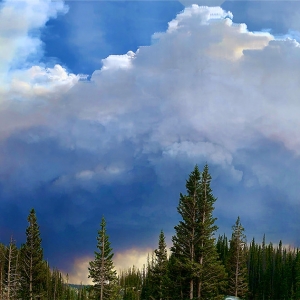Federal Water Tap, October 5: Army Corps Evaluates Multibillion-Dollar Flood Projects for Houston
The Rundown
The Army Corps of Engineers wants public input as it assesses ways to reduce flood risk along Houston waterways. FEMA begins accepting applications for $500 million in flood resilience grants. The Department of Health and Human Services wants to test sewage as a coronavirus early-warning system. Three agencies sign a new management plan for federal dams in the Columbia River basin. Regulators say there is enough evidence to list two freshwater mussel species as threatened. USDA begins accepting applications for a pilot program for septic systems that fail due to unsuitable soil. And lastly, the EPA considers revising up to eight national drinking water rules.
By the Numbers
$500 million: Grant funding available to help communities reduce the risk of catastrophic floods. Of that amount, some $20 million is set aside for tribes. The Building Resilient Infrastructure and Communities grants encourage projects that update building codes and those that incorporate nature-based flood prevention: things like wetlands, green spaces, and room for water to flow. (FEMA)
$5 million: Grant funding available for a new pilot program to evaluate and test small-scale wastewater treatment systems for poor communities with septic systems that fail due to unsuitable soil. Applications from regional research collaboratives are due November 4 and can be submitted via www.grants.gov. (USDA)
In context: Septic Infrastructure in the U.S.
News Briefs
Tracking the Coronavirus in Sewage
The Department of Health and Human Services is seeking a contractor that could help test sewage for traces of the new coronavirus, CNBC reports.
Evidence of genetic material from the SARS-CoV-2 virus in sewage can be used to identify potential outbreaks more quickly than clinical data. The CDC has already said it would organize a national surveillance network.
The department says that testing will begin with a network of wastewater plants that treat the sewage of about 10 percent of U.S. residents. The project could scale up to cover about 30 percent of the country’s population, largely in the biggest cities.
CNBC notes that the solicitation appears to be tailored toward the services of a particular company: BioBot, a startup that began testing sewage earlier this year and now has partnerships in 42 states.
Threatened Mussels
The U.S. Fish and Wildlife Service says that there is enough evidence to list two freshwater mussel species as “threatened” under federal protection laws.
Critical habitat for the longsolid and round hickorynut mussels extends from Alabama to Pennsylvania. This includes about 1,000 miles of river habitat.
Comments on the proposed listing are being accepted through December 28. Submit them via www.regulations.gov using docket number FWS-R4-ES-2020-0010.
Studies and Reports
Houston Flooding Study
The Army Corps of Engineers released an interim report as part of its assessment of ways to reduce flooding risk along Houston’s Buffalo Bayou.
Options include a new reservoir (estimated cost: $2.1 billion to $2.9 billion), dredging and widening Buffalo Bayou ($946 million to $1.2 billion), and relocating businesses and apartments downstream ($2.3 billion). There are a number of smaller options that could be included in those three options.
The Corps operates two dams on the bayou and its tributaries, which were inundated during Hurricane Harvey in 2017. Several factors account for the area’s increasing flood risk since the dams were built in the 1940s: population growth, more pavement, and higher-intensity rainfall.
The interim report does not make any conclusions or recommendations. Those will be part of the final report. Before then, the public has a chance to weigh in. Submit comments by November 2 to BBTRS@usace.army.mil.
Columbia River Dams
Three federal agencies signed a record of decision on a new management plan for federal dams in the Columbia River basin.
Intended to improve the health of the basin’s salmon runs while accounting for the dams’ other authorized purposes — flood control, navigation, hydropower, water supply — the plan prioritizes spilling more water from the dams. Spilling water is a way to prevent outbound salmon from being killed in the turbines.
The plan does not take the step that some environmental groups and tribes had wanted: breaching four dams on the Lower Snake River.
On the Radar
EPA Drinking Water Rules Review
Every six years, the EPA is required to review federal drinking water rules to determine, based on new data, whether any require revision.
The latest review found eight rules that could need updating. Those rules relate to microbial contaminants like Legionella and Giardia, as well as the chemical byproducts of water disinfection.
The agency will hold an online meeting on October 14 and 15 to hear expert testimony and public input about potential revisions.
The agenda is here. Register via the above link by October 12.
In context: Who Regulates U.S. Drinking Water, and How?
Environmental Finance Board Meeting
Scheduling conflict alert: the Environmental Finance Advisory Board, which advises the EPA on the important question ‘How to pay for it?’, will hold a public meeting on October 14 and 15.
On the agenda: the EPA Office of Water will respond to a board report on stormwater financing and consolidating smaller water systems in regional blocs.
What Is a Showerhead
The Department of Energy is giving the public an additional two weeks to comment on its proposal to revise the definition of “showerhead.”
The revision would allow for high-end, multi-nozzle fixtures to use more water than current efficiency standards.
Submit comments by October 14. Send them to Showerheads2020TP0002@ee.doe.gov with the subject line EERE-2014-BT-TP-0002.
Federal Water Tap is a weekly digest spotting trends in U.S. government water policy. To get more water news, follow Circle of Blue on Twitter and sign up for our newsletter.
Brett writes about agriculture, energy, infrastructure, and the politics and economics of water in the United States. He also writes the Federal Water Tap, Circle of Blue’s weekly digest of U.S. government water news. He is the winner of two Society of Environmental Journalists reporting awards, one of the top honors in American environmental journalism: first place for explanatory reporting for a series on septic system pollution in the United States(2016) and third place for beat reporting in a small market (2014). He received the Sierra Club’s Distinguished Service Award in 2018. Brett lives in Seattle, where he hikes the mountains and bakes pies. Contact Brett Walton






Leave a Reply
Want to join the discussion?Feel free to contribute!